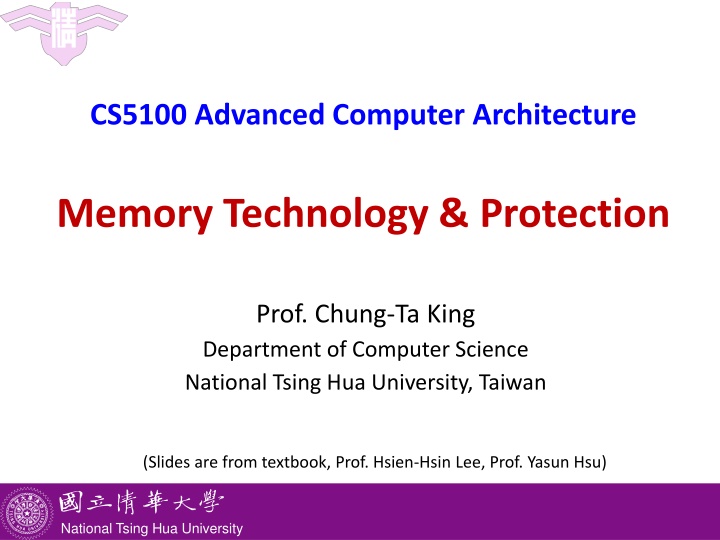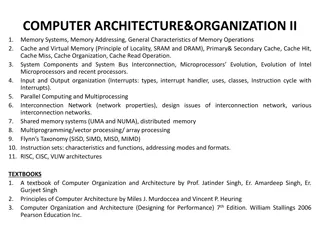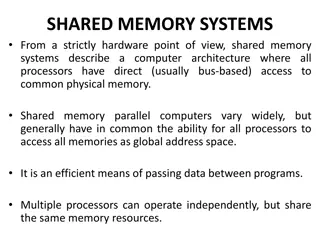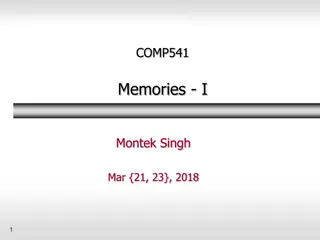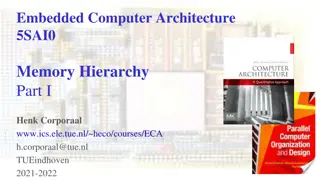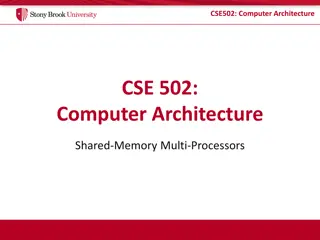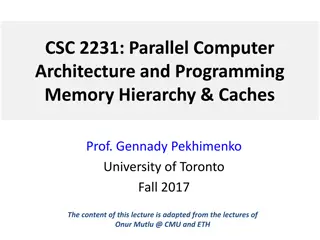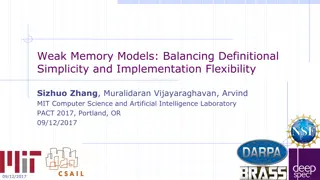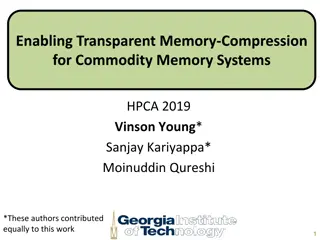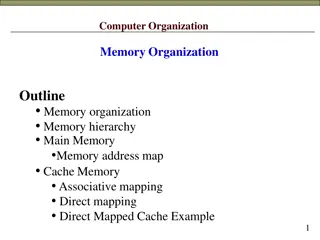Advanced Memory Technology & Protection in Computer Architecture
This lecture delves into the advancements in memory technology focusing on internal organizations of memory chips, virtual memory, and virtual machines for computer system protection. Past and current memory designs, performance metrics, and the workings of SRAM and DRAM are discussed in detail, shedding light on key concepts and innovations in the field of computer architecture.
Download Presentation

Please find below an Image/Link to download the presentation.
The content on the website is provided AS IS for your information and personal use only. It may not be sold, licensed, or shared on other websites without obtaining consent from the author.If you encounter any issues during the download, it is possible that the publisher has removed the file from their server.
You are allowed to download the files provided on this website for personal or commercial use, subject to the condition that they are used lawfully. All files are the property of their respective owners.
The content on the website is provided AS IS for your information and personal use only. It may not be sold, licensed, or shared on other websites without obtaining consent from the author.
E N D
Presentation Transcript
CS5100 Advanced Computer Architecture Memory Technology & Protection Prof. Chung-Ta King Department of Computer Science National Tsing Hua University, Taiwan (Slides are from textbook, Prof. Hsien-Hsin Lee, Prof. Yasun Hsu) National Tsing Hua University
About This Lecture Goal: To understand the technology inside the memory chips and their innovative, internal organizations To understand how virtual memory and virtual machines provide protections to a computer system Outline: Memory technology and optimizations (Sec. 2.3) Protection: virtual memory and virtual machines (Sec. 2.4) 1 National Tsing Hua University
Memory Background Past memory designs focused on organizing multiple DRAM chips, e.g., multiple banks. Recent innovations are more inside DRAM chips Performance metrics: Latency: affect cache miss penalty Access time: time between request and word arrival Cycle time: minimum time between unrelated requests Bandwidth: I/O and large block miss penalty (L2) Main memory uses DRAM, cache uses SRAM Size: DRAM/SRAM @ 4-8, Cost/cycle time: SRAM/DRAM @ 8-16 2 National Tsing Hua University
Memory Background SRAM: Typically 6 transistors/bit no refresh access time close to cycle time, but area is 10X Requires low power to retain bit Address not divided: full address DRAM: One transistor/bit destructive read Must be rewritten after read and periodically refreshed Every ~ 8 ms and each row can be refreshed simultaneously Addresses divided into 2 halves (memory as a 2D matrix): Upper half of address: row access strobe (RAS) Lower half of address: column access strobe (CAS) 3 National Tsing Hua University
DRAM Cell and DRAM Access Word Line (Control) Destructive read rewritten after read cycle time longer than access time Storage Capacitor Leaky charges refresh periodically Bit Line (Data) 1T1C DRAM cell Fig. 2.12 4 National Tsing Hua University
DRAM Access Access to a closed row If another row already active, first issue PRECHARGE (close the active row) ACTIVATE to open a new row READ/WRITE to access row buffer Access to an open row (the row is in a buffer) No need for ACTIVATE command READ/WRITE to access row buffer 5 National Tsing Hua University
DRAM Refresh Leaky storage Periodic refresh across DRAM rows (~ 8 ms) Read and write the same data back Each row can be refreshed simultaneously Un-accessible when refreshing Variable memory latency and cache miss penalty Example: 4K rows in a DRAM, 100ns read cycle, decay in 64ms 4096*100ns = 410 s to refresh once 410 s / 64ms = 0.64% unavailability 6 National Tsing Hua University
Memory Design Amdahl suggests a rule of thumb: Memory capacity should grow linearly with processor speed for a balanced system, e.g., 1000 MB for 1000 MIPS But DRAM performance cannot catch up with processor performance (Fig. 2.13) Row access time improves ~5%/year, while CAS transfer time at ~10% Memory capacity growth is actually slowing down Before 1998, 4X every 3 years (following Moore s Law) 1998~2006, 2X every 2 years 2006~2010, 2X only Memory design becomes more challenging 7 National Tsing Hua University
Memory Optimizations Multiple accesses to the row buffer without another row access time Synchronous DRAM (SDRAM) Original DRAMs had asynch. interface to mem. controller Add clock to DRAM interface for repeated transfers without handshaking overhead Burst mode w/o new address and with critical word first Wider interfaces with 4-bit or 16-bit buses Multiple banks inside a DRAM chip (Fig. 2.12) DRAM address now consists of bank number, row address, and column address 8 National Tsing Hua University
Memory Optimizations Double data rate (DDR): Transfer data on rising as well as falling edge of DRAM clock DDR: (Fig. 2.14) A 133 MHz DDR chip is called DDR266 and can transfer 266 Mbits/sec A DIMM (dual inline memory module) with DDR chips can transfer 133 MHz 2 8 bytes 2100 MB/sec (PC2100) DDR2: Lower power from 2.5 V 1.8 V Higher clock rates: 266 MHz, 333 MHz, 400 MHz DDR3: 1.5 V, 800 MHz DDR4: 1-1.2 V, 1600 MHz 9 National Tsing Hua University
Memory Optimizations DRAM scheduling policies In what order should we service DRAM requests FCFS (First come first serve) Oldest request first FR-FCFS (First ready, FCFS) [Rixner et al. ISCA 2000] Goal: maximize row buffer hit rate maximize DRAM throughput Row hit first Oldest first (Row 0, Col 0) (Row 1, Col 10) (Row 0, Col 1) FCFS FR-FCFS (Row 0, Col 0) (Row 0, Col 1) (Row 1, Col 10) 10 National Tsing Hua University
Memory Optimizations Graphics memory (GDRAM): Based on SDRAM for high bandwidth demands of GPU Achieve 2~5 X bandwidth per DRAM vs. DDR3 Wider interfaces: 32 bits vs. 16 bits Higher clock rate: connected directly to GPU and attached to board via soldering instead of socketted DIMM modules Reducing power in SDRAMs: Lower voltage (to 1.35 ~ 1.5 V) Use multiple banks (only the row in a single bank is read) Power down mode (ignores clock, continues to refresh) 11 National Tsing Hua University
Flash Memory A type of EEPROM (Electronically Erasable Programmable Read-Only Memory) Must be erased (in blocks) before being overwritten Static and non-volatile, drawing lower power when not reading or writing Limited number of write cycles (~100,000 times) wear levering Cheaper than SDRAM, more expensive than disk Slower than SRAM, faster than disk Future: a replacement for hard disks and an intermediate storage between DRAM and disk 12 National Tsing Hua University
Memory Dependability Memory is susceptible to cosmic rays Soft errors: dynamic errors Changes to a cell s contents, not circuitry Detected and fixed by error correcting codes (ECC) Hard errors: permanent errors May be due to manufacturing defects Use sparse rows to replace defective rows 13 National Tsing Hua University
Outline Memory technology and optimizations (Sec. 2.3) Protection: virtual memory and virtual machines (Sec. 2.4) 14 National Tsing Hua University
Virtual Memory As a part of memory hierarchy Separation of logical memory from physical memory Virtual address: generated by CPU, seen by compiler and linker Physical address: seen by the memory Allow only a part of program in memory for execution logical address space can be much larger than physical Serve to protect processes from each other Keeps processes in their own memory space Yet allow memory spaces to be shared among processes 15 National Tsing Hua University
Virtual Memory Design How is virtual memory different from caches? What controls replacement? Size (transfer unit, mapping mechanisms) Review: four questions for virtual memory: Q1: Where can a block be places in the upper level? Q2: How is a block found if it is in the upper level? Q3: Which block should be replaced on a miss? Q4: What happens on a write? 16 National Tsing Hua University
Implementation of Virtual Memory Architecture must: Provide restartable (or resumable) instructions Must resume program after recovering from a page fault Mark a page not present and raise a page fault when referencing such a page Have status bits per page R (referenced): for use by replacement algorithm M (modified): to determine when page is dirty OS maintains Page table for user process, page frame table, free page list Pages evicted using a replacement policy, e.g. random, LRU If M-bit is clear, needn t copy page back to disk write back 17 National Tsing Hua University
Protection by Virtual Memory OS & architecture work together to provide protection Role of architecture for VM protection: Provide user mode and supervisor mode Provide a portion of CPU state that a user process can use but not write, e.g., user/supervisor mode bit, exception enable/disable bit, memory protection information, etc. Provide mechanisms for switching between user mode and supervisor mode, e.g., system calls Provide mechanisms to limit memory accesses Provide protection restrictions to each page, e.g. read-only Provide TLB for fast translation of addresses 18 National Tsing Hua University
Privileged Mode for Protection Supervisor mode or kernel mode In unprivileged mode (user mode) Can only access memory in range [B, B+L-1] Cannot access B and L, and I/O devices Relocation registers and I/O devices are privileged resources In privileged mode a process can access everything Can access privileged registers, all of memory Can access system tables, e.g. load B and L for other processes, allocate and deallocate memory segments, access I/O devices 19 National Tsing Hua University
Switching between Modes Enter kernel mode only by system calls Call gates x86 INT #<int number> Atomically change Control flow (PC) Addressing environment Usually requires a special instruction for both entry and return Services must be completely trusted User Code User LNS Gates User Mode Privileged Mode Service 1 Service 2 Service 3 All Memory 20 National Tsing Hua University
Fast Address Translation How often address translation occurs? Where the page table is kept? Keep translation in the hardware Use Translation Lookaside Buffer (TLB) Instruction-TLB and Data-TLB Essentially a cache (tag array = VPN, data array=PPN) Small (32 to 256 entries are typical) Typically fully associative (using a content addressable memory, CAM) or highly associative to minimize conflicts Include process ID or be flushed on each process switch or system call Referenced and modified bits are copied back on changes 21 National Tsing Hua University
Protection via Virtual Machines Support isolation and security First developed in the late 1960s Focus on virtual machines that provide a complete system-level environment at the binary ISA level Particularly on virtual machines that support same ISA as the underlying hardware system virtual machine (SVM) e.g., IBM VM/370, VMware ESX, Xen Present the illusion that the user has the entire computer, including a copy of OS Other benefits of virtual machines: Managing software: run programs on own OS releases Managing hardware: migration 22 National Tsing Hua University
Virtual Machines The software that supports VMs is called virtual machine monitor (VMM) or hypervisor Individual virtual machines run under the monitor are called guest VMs The underlying hardware, whose resources are shared by guest VMs, is called the host VMM determines how to map virtual resources to physical resources Time-shared, partitioned, emulated in software Processor virtualization cost depends on workload User-level processor-bound (SPEC CPU2006) vs. I/O-intensive 23 National Tsing Hua University
Requirements of VMM Present a software interface to guest software Isolate the state of guests from each other Protect itself from guest software Must control everything on the computer system, even with guest VM and OS temporarily using them Be at a higher privilege level than guest VMs If a guest OS attempts to access or modify information related to hardware resources via a privileged instruction, it will trap to the VMM; VMM can intercept and support a virtual version of the sensitive information as the guest OS expects 24 National Tsing Hua University
Impact of VMs on Virtual Memory Virtualization of memory: Each guest OS maintains its own set of page tables VMM adds a level of memory between physical and virtual memory called real memory VMM maintains shadow page table that maps guest virtual addresses to physical addresses Requires VMM to detect guest s changes to its own page table Occurs naturally if accessing the page table pointer is a privileged operation Virtualization of I/O 25 National Tsing Hua University
Summary Memory technology and optimizations DRAM Protection: virtual memory and virtual machines Virtual memory Virtual machine Have you Understood the technology inside the memory chips and other innovative, internal organizations Understood how virtual memory and virtual machines provide protections to a computer system 26 National Tsing Hua University
